Assessment of Drought Severity and Vulnerability in the Lam Phaniang River Basin, Thailand
Abstract
:1. Introduction
2. Materials and Methods
2.1. Study Area
2.2. Data Collection
2.3. Climate Models for Climate Scenarios
2.3.1. Applicability of GCM Dataset
2.3.2. Bias Correction
2.4. Projection of Future Land Use Change
2.5. Assessment of Water Availability and Demand
2.5.1. WEAP Model Set-Up
2.5.2. Water Demand Calculation for Different Purposes
2.5.3. WEAP Model Calibration and Validation
2.6. Assessment of Drought Hazard and Vulnerability
2.6.1. Calculation of SPEI Drought Index
2.6.2. Weights and Ratings for Evaluating Drought Potential
2.6.3. Calculation of Drought Hazard Index
2.6.4. Calculation of Drought Vulnerability Index
- Sensitivity Indicator (SI) was used to describe the degree to which the sub-districts within the Lam Phaniang River Basin were adversely affected by drought with either positive or negative impacts. In this study, the WEAP simulated water demand for domestic use, agriculture, and industry, was used to measure the sensitivity to the drought-associated complications, as higher water demand can lead to more vulnerability to the adverse impacts of drought.
- Exposure Indicator (EI) to drought was captured by water shortage for domestic use, agriculture, and industry, under climate change impacts for affected sub-districts within the Lam Phaniang River Basin.
- Adaptive Capacity Indicator (ACI), which is a function of three determinants, including socio-economic, technological, and institutional capabilities, was considered since the greater the adaptive capacity of the Lam Phaniang River Basin to a specific climate event, the less vulnerable to drought due to climate change. In this study, two indicators, i.e., Gross Provincial Product (GPP) and surface runoff simulated by WEAP, were used to quantify adaptive capacity to climate change, because the higher the GPP and more sufficient the water supply are, the higher the adaptive capacity.
2.7. Assessment of Drought Risk
3. Results and Discussion
3.1. Analysis of Climate Change Impacts
3.2. Analysis of Land Use Change
3.3. Calibration and Validation Results of WEAP Model
3.4. Analysis of River Basin Water Balance
3.5. Comprehensive Analysis of Drought Risk Assessment
4. Conclusions
Author Contributions
Funding
Acknowledgments
Conflicts of Interest
References
- Krittasudthacheewa, C.; Polpanich, O.; Bush, A.; Srikuta, P.; Kemp-Benedict, E.; Inmuong, Y.; Inmuong, U.; Featherston, P.; Eagleton, G.; Naruchaikusol, S.; et al. Final Report for the Northeast Thailand Futures: A Local Study of the Exploring Mekong Region Futures Project. Report submitted to Commonwealth Scientific and Industrial Research Organisation. 2012. Available online: https://www.weap21.org/downloads/07_Final%20Completion%20Report_NE%20Thailand_Futures_12Dec2012.pdf (accessed on 20 March 2021).
- Van Dau, Q.; Kuntiyawichai, K.; Suryadi, F.X. Drought Severity Assessment in the Lower Nam Phong River Basin, Thailand. Songklanakarin J. Sci. Technol. 2017, 40, 985–992. [Google Scholar]
- Ahokpossi, Y. Analysis of the Rainfall Variability and Change in the Republic of Benin (West Africa). Hydrol. Sci. J. 2018, 63, 2097–2123. [Google Scholar] [CrossRef]
- Meliho, M.; Khattabi, A.; Jobbins, G.; Sghir, F. Impact of Meteorological Drought on Agriculture in the Tensift Watershed of Morocco. J. Water Clim. Chang. 2020, 11, 1323–1338. [Google Scholar] [CrossRef]
- Silungwe, F.R.; Graef, F.; Bellingrath-Kimura, S.D.; Tumbo, S.D.; Kahimba, F.C.; Lana, M.A. Analysis of Intra and Interseasonal Rainfall Variability and its Effects on Pearl Millet Yield in a Semiarid Agroclimate: Significance of Scattered Fields and Tied Ridges. Water 2019, 11, 578. [Google Scholar] [CrossRef] [Green Version]
- Babel, M.S.; Agarwal, A.; Swain, D.K.; Herath, S. Evaluation of Climate Change Impacts and Adaptation Measures for Rice Cultivation in Northeast Thailand. Clim. Res. 2011, 46, 137–146. [Google Scholar] [CrossRef] [Green Version]
- Polthanee, A.; Promkhumbut, A.; Bamrungrai, J. Drought Impact on Rice Production and Farmers’ Adaptation Strategies in Northeast Thailand. Int. J. Environ. Rural Dev. 2014, 5-1, 45–52. [Google Scholar]
- Prabnakorn, S.; Maskey, S.; Suryadi, F.X.; de Fraiture, C. Rice Yield in Response to Climate Trends and Drought Index in the Mun River Basin, Thailand. Sci. Total Environ. 2018, 621, 108–119. [Google Scholar] [CrossRef] [PubMed]
- Department of Water Resources. The Comprehensive Water Resources Management Plan in the Chi River Basin: Report for the Lam Phaniang River Basin; Ministry of Natural Resources and Environment: Bangkok, Thailand, 2006. (In Thai) [Google Scholar]
- Secretariat Office of the Chi River Basin Committee. Management of the Chi River Basin; Water Resources Regional Office 4, Department of Water Resources, Ministry of Natural Resources and Environment: Khon Kaen, Thailand, 2012. (In Thai) [Google Scholar]
- Torma, C.; Giorgi, F.; Coppola, E. Added Value of Regional Climate Modeling over Areas Characterized by Complex Terrain—Precipitation over the Alps. J. Geophys. Res. Atmos. 2015, 120, 3957–3972. [Google Scholar] [CrossRef]
- Durman, C.F.; Gregory, J.M.; Hassell, D.C.; Jones, R.G.; Murphy, J.M. A Comparison of Extreme European Daily Precipitation Simulated by a Global and a Regional Climate Model for Present and Future Climates. Q. J. R. Meteorol. Soc. 2001, 127, 1005–1015. [Google Scholar] [CrossRef]
- Herrera, S.; Fita, L.; Fernández, J.; Gutiérrez, J.M. Evaluation of the Mean and Extreme Precipitation Regimes from the ENSEMBLES Regional Climate Multimodel Simulations over Spain. J. Geophys. Res. 2010, 115, D21117. [Google Scholar] [CrossRef] [Green Version]
- Rathjens, H.; Bieger, K.; Srinivasan, R.; Chaubey, I.; Arnold, J.G. Cmhyd User Manual: Documentation for Preparing Simulated Climate Change Data for Hydrologic Impact Studies. Available online: https://swat.tamu.edu/media/115265/bias_cor_man.pdf (accessed on 6 January 2020).
- Teutschbein, C.; Seibert, J. Bias Corretion of Regional Climate Model Simulations for Hydrological Climate-Change Impact Studies: Review and Evaluation of Different Methods. J. Hydrol. 2012, 456–457, 12–29. [Google Scholar] [CrossRef]
- Heistermann, M.; Muller, C.; Ronneberger, K. Land in Sight? Achievements, Deficits and Potentials of Continental to Global Scale Modeling. Agric. Ecosyst. Environ. 2006, 114, 141–158. [Google Scholar] [CrossRef]
- Eastman, J.R. Terrset Geospatial Monitoring and Modeling System; Clark Labs, Clark University: Worcester, MA, USA, 2016. [Google Scholar]
- Kuntiyawichai, K.; Sri-Amporn, W.; Wongsasri, S.; Chindaprasirt, P. Anticipating of Potential Climate and Land Use Change Impacts on Floods: A Case Study of the Lower Nam Phong River Basin. Water 2020, 12, 1158. [Google Scholar] [CrossRef] [Green Version]
- Kamal, N.; Imran, M.; Tripati, N.K. Greening the Urban Environment using Geospatial Techniques, A Case Study of Bangkok, Thailand. Procedia Environ. Sci. 2017, 37, 141–152. [Google Scholar] [CrossRef]
- Lambin, E.F. Modelling Deforestation Processes: A Review; TREES Publications Series B. Research Report No.1, EUR 15744 EN; European Commission: Luxenbourg, 1994. [Google Scholar]
- Moghadam, H.S.; Helbich, M. Spatiotemporal Urbanization Processes in the Megacity of Mumbai, India: A Markov Chains-Cellular Automata Urban Growth Model. Appl. Geogr. 2013, 40, 140–149. [Google Scholar] [CrossRef]
- Veldkamp, A.; Lambin, E.F. Predicting Land-Use Change. Agric. Ecosyst. Environ. 2001, 85, 1–6. [Google Scholar] [CrossRef]
- Stockholm Environment Institute (SEI). WEAP Tutorial: A Collection of Stand-Alone Modules to Aid in Learning the WEAP Software; Stockholm Environment Institute: Stockholm, Sweden, 2016. [Google Scholar]
- Okyereh, S.A.; Ofosu, E.A.; Kabobah, A.T. Modelling the Impact of Bui Dam Operations on Downstream Competing Water Uses. Water-Energy Nexus 2019, 2, 1–9. [Google Scholar] [CrossRef]
- Me, W.; Abell, J.M.; Hamilton, D.P. Effects of Hydrologic Conditions on SWAT Model Performance and Parameter Sensitivity for a Small, Mixed Land Use Catchment in New Zealand. Hydrol. Earth Syst. Sci. 2015, 19, 4127–4147. [Google Scholar] [CrossRef] [Green Version]
- Ligaray, M.; Kim, M.; Baek, S.; Ra, J.S.; Chun, J.A.; Park, Y.; Boithias, L.; Ribolzi, O.; Chon, K.; Cho, K.H. Modeling the Fate and Transport of Malathion in the Pagsanjan-Lumban Basin, Philippines. Water 2017, 9, 451. [Google Scholar] [CrossRef] [Green Version]
- Vicente-Serrano, S.M.; Begueria, S.; Lopez-Moreno, J.I. A Multiscalar Drought Index Sensitive to Global Warming: The Standardized Precipitation Evapotranspiration Index. J. Clim. 2010, 23, 1696–1718. [Google Scholar] [CrossRef] [Green Version]
- Zeng, Z.; Wu, W.; Li, Z.; Zhou, Y.; Huang, H. Quantitative Assessment of Agricultural Drought Risk in Southeast Gansu Province, Northwest China. Sustainability 2019, 11, 5533. [Google Scholar] [CrossRef] [Green Version]
- Smith, R.M. Comparing Traditional Methods for Selecting Class Intervals on Choropleth Maps. Prof. Geogr. 1986, 38, 62–67. [Google Scholar] [CrossRef]
- Parry, M.L.; Canziani, O.F.; Palutikof, J.P.; van der Linden, P.J.; Hanson, C.E. (Eds.) IPCC. Climate Change 2007: Impacts, Adaptation and Vulnerability. In Contribution of Working Group II to the Fourth Assessment Report of the Intergovernmental Panel on Climate Change; Cambridge University Press: Cambridge, UK, 2007; 976p. [Google Scholar]
- Birkmann, J. Risk and Vulnerability Indicators at Different Scales: Applicability, Usefulness and Policy Implications. Environ. Hazards 2007, 7, 20–31. [Google Scholar] [CrossRef]
- Shiferaw, H.; Gebremedhin, A.; Gebretsadkan, T.; Zenebe, A. Modelling Hydrological Response under Climate Change Scenarios using SWAT Model: The Case of Ilala Watershed, Northern Ethiopia. Modeling Earth Syst. Environ. 2018, 4, 437–449. [Google Scholar] [CrossRef]
- Pipitpukdee, S.; Attavanich, W.; Bejranonda, S. Climate Change Impacts on Sugarcane Production in Thailand. Atmosphere 2020, 11, 408. [Google Scholar] [CrossRef] [Green Version]
- Office of Strategy Management. The 4-Year Development Plan of Upper Northeastern Provincial Cluster 1 (2017–2021); The Office of Strategy Management: Upper Northeastern Provincial Cluster 1: Udon Thani, Thailand, 2015. (In Thai) [Google Scholar]
- Office of the National Economic and Social Development Council. The Direction of the Twelfth National Economic and Social Development Plan (2017–2021); Office of The Prime Minister: Bangkok, Thailand, 2017. (In Thai) [Google Scholar]
- Gitz, V.; Meybeck, A.; Pinizzotto, S.; Nair, L.; Penot, E.; Baral, H.; Jianchu, X. Sustainable Development of Rubber Plantations in a Context of Climate Change: Challenges and Opportunities; FTA Brief 4; CIFOR: Bogor, Indonesia, 2020. [Google Scholar]
- Yates, D.; Purkey, D.; Sieber, J.; Huber-Lee, A.; Galbraith, H. WEAP21—A Demand-, Priority-, and Preference-Driven Water Planning Model. Water Int. 2005, 30, 501–512. [Google Scholar] [CrossRef]
- Krause, P.; Boyle, D.P.; Base, F. Comparison of Different Efficiency Criteria for Hydrological Model Assessment. Adv. Geosci. 2005, 5, 89–97. [Google Scholar] [CrossRef] [Green Version]
- Pandhumas, T.; Kuntiyawichai, K.; Jothityangkoon, C.; Suryadi, F.X. Assessment of Climate Change Impacts on Drought Severity using SPI and SDI over the Lower Nam Phong River Basin, Thailand. Eng. Appl. Sci. Res. 2020, 47, 326–338. [Google Scholar]
- Vogt, J.V.; Naumann, G.; Masante, D.; Spinoni, J.; Cammalleri, C.; Erian, W.; Pischke, F.; Pulwarty, R.; Barbosa, P. Drought Risk Assessment and Management. A Conceptual Framework; EUR 29464 EN; Publications Office of the European Union: Luxembourg, 2018; ISBN 978-92-79-97469-4. [Google Scholar] [CrossRef]
- UNDRR. Global Assessment Report on Disaster Risk Reduction, Geneva, Switzerland; United Nations Office for Disaster Risk Reduction UNDRR: Geneva, Switzerland, 2019. [Google Scholar]
- Rouault, M.; Richard, Y. Intensity and Spatial Extension of Drought in South Africa at Different Timescales. Water SA 2003, 29, 489–500. [Google Scholar]
- Livada, I.; Assimakopoulos, V.D. Spatial and Temporal Analysis of Drought in Greece using the Standardized Precipitation Index (SPI). Theor. Appl. Climatol. 2007, 89, 143–153. [Google Scholar] [CrossRef]
- Roushangar, K.; Ghasempour, R.; Nourani, V. The Potential of Integrated Hybrid Pre-Post-Processing Techniques for Short- to Long-Term Drought Forecasting. J. Hydroinform. 2021, 23, 117–135. [Google Scholar] [CrossRef]
- Alahacoon, N.; Edirisinghe, M.; Ranagalage, M. Satellite-Based Meteorological and Agricultural Drought Monitoring for Agricultural Sustainability in Sri Lanka. Sustainability 2021, 13, 3427. [Google Scholar] [CrossRef]
- TNMC. Drought and Climate Change Impacts and Vulnerability Assessment for Northeast Thailand: Final Report; Thai National Mekong Committee Secretariat: Vientiane, Laos, 2016. [Google Scholar]
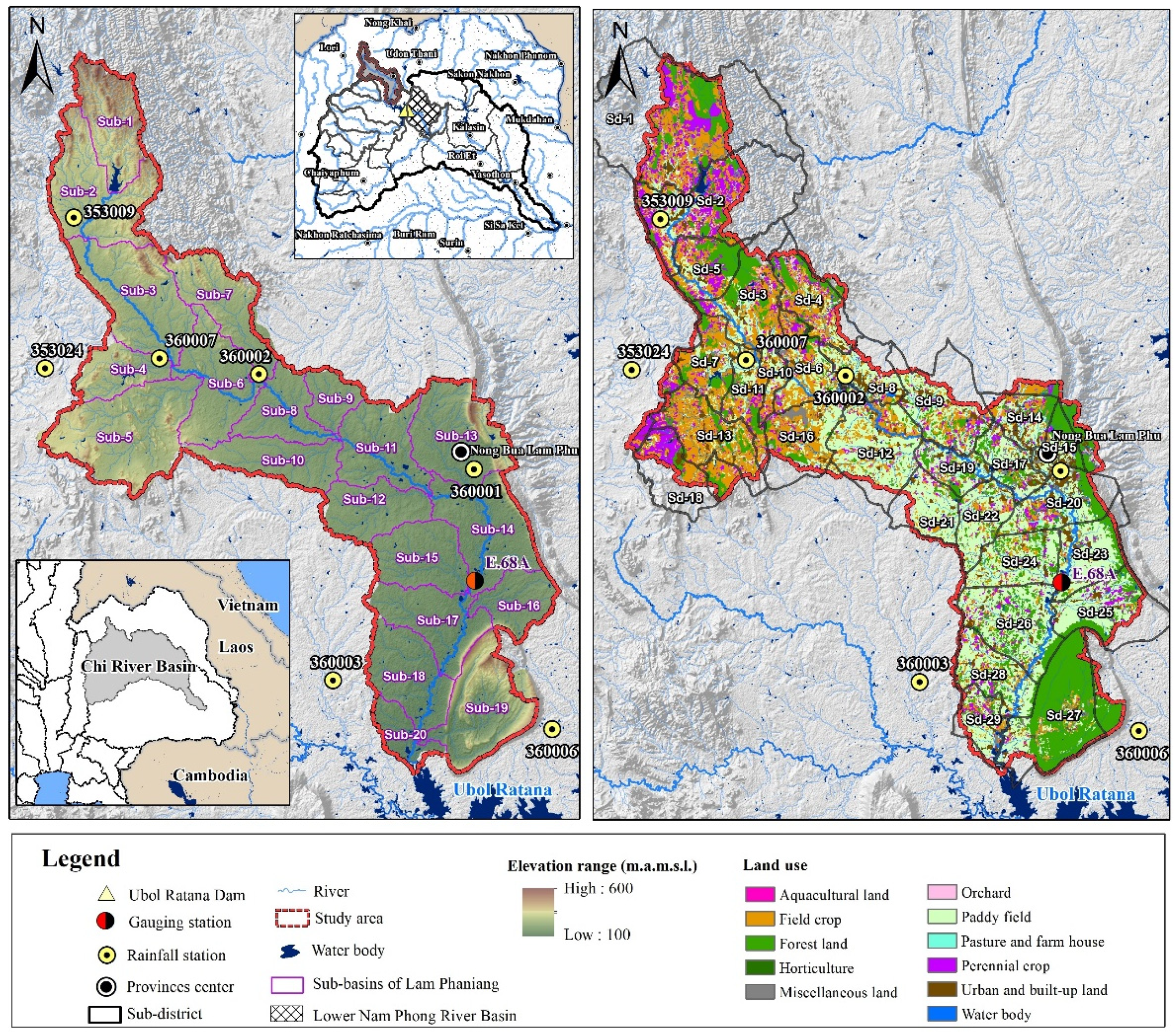
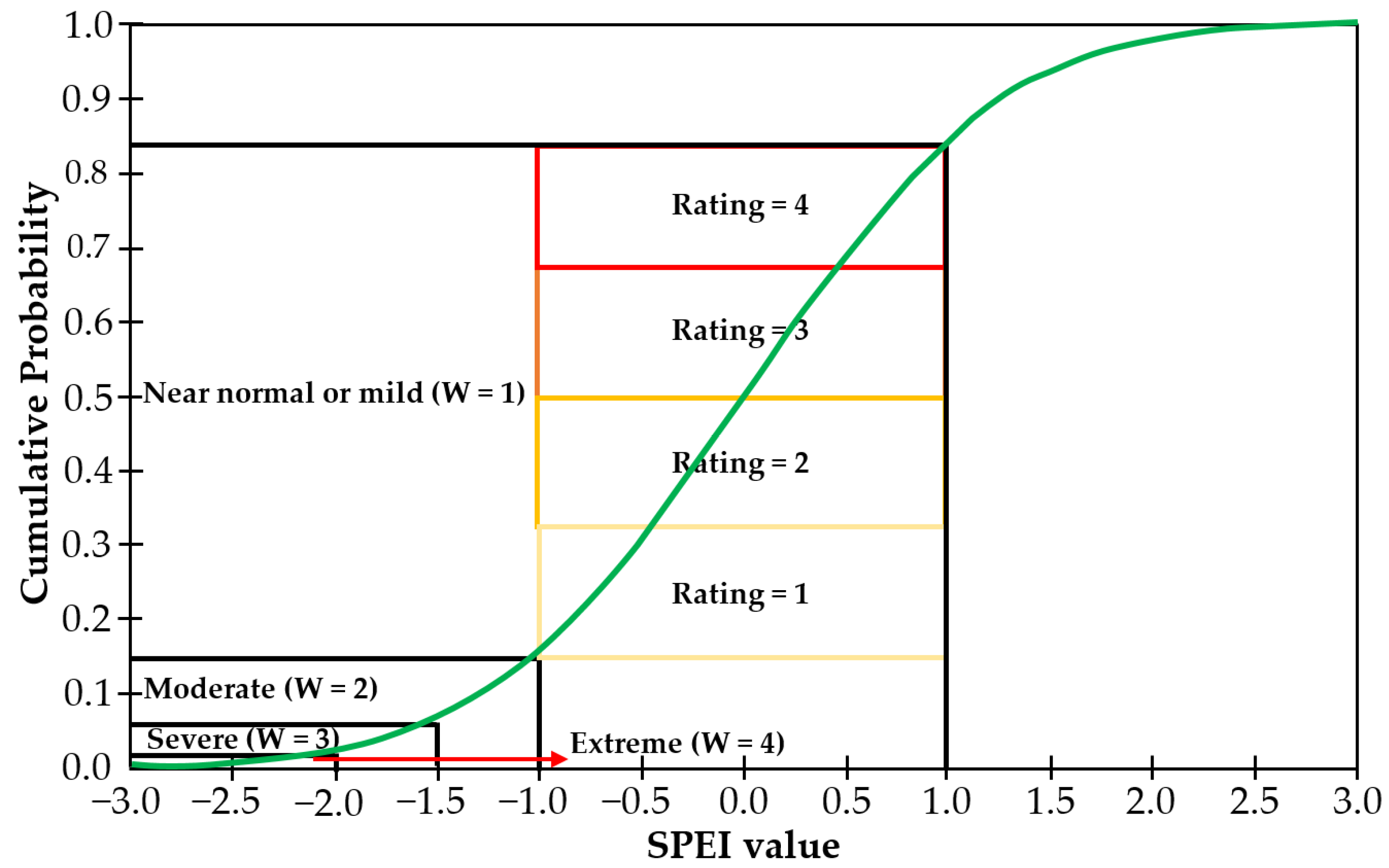
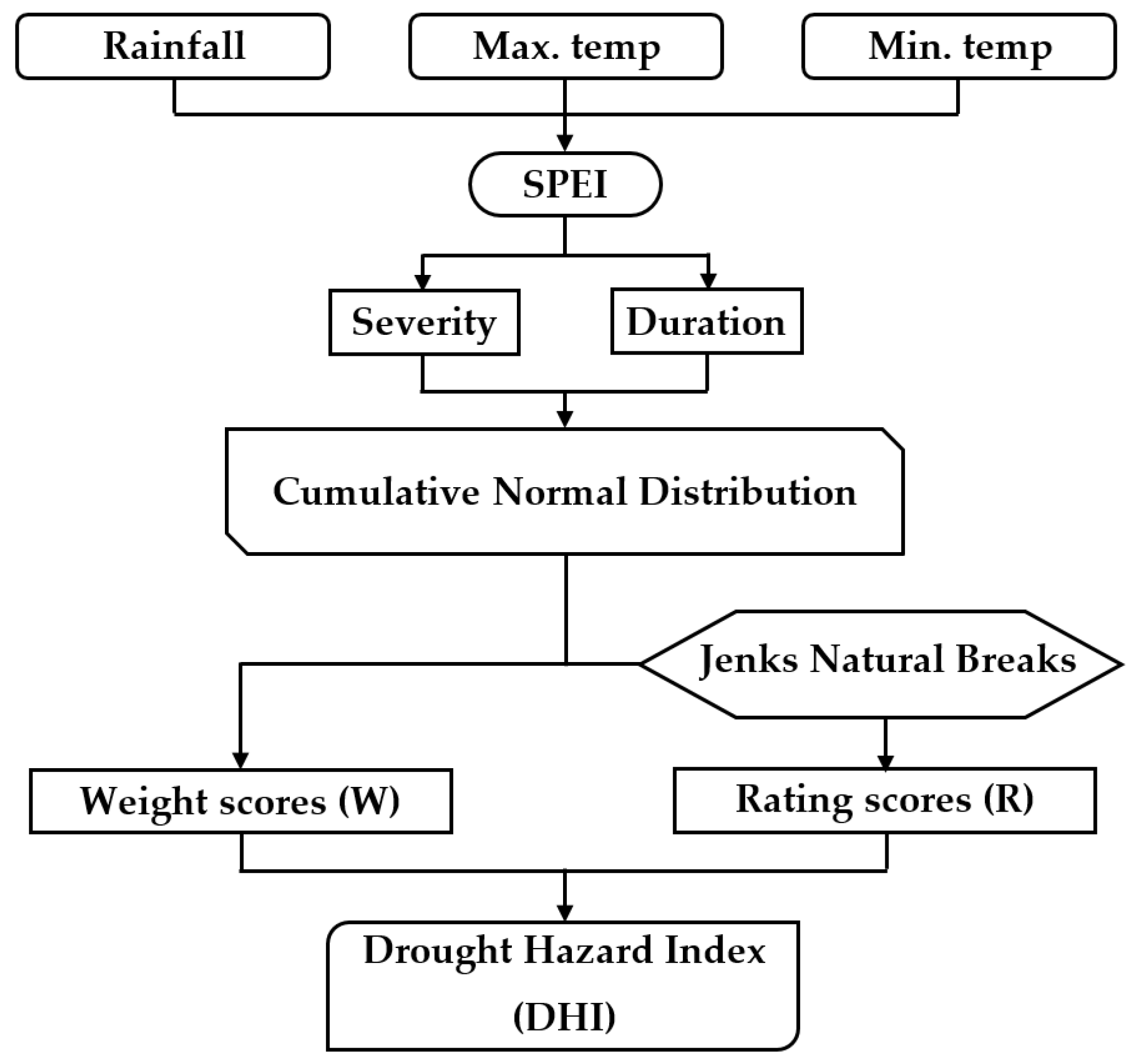

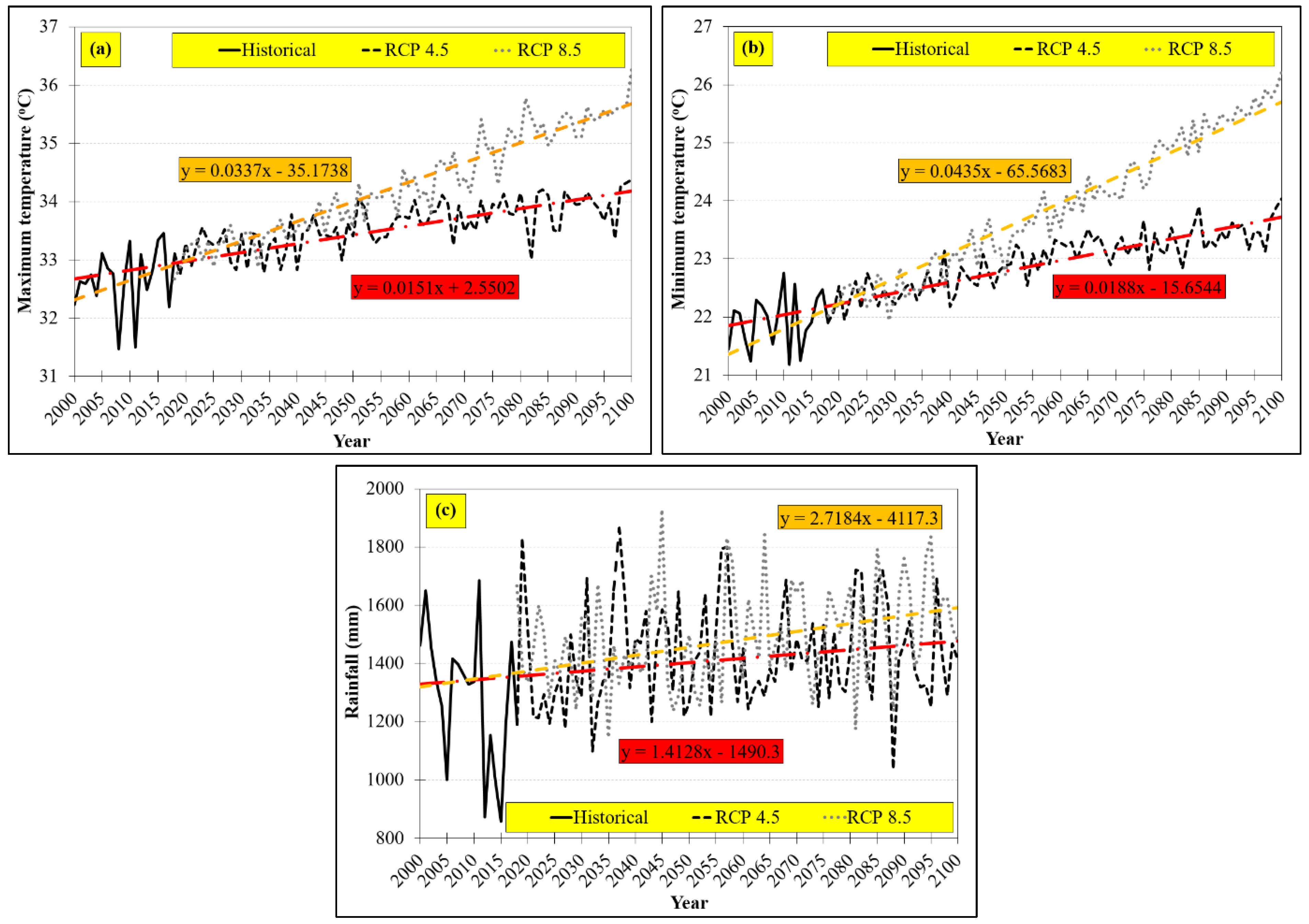
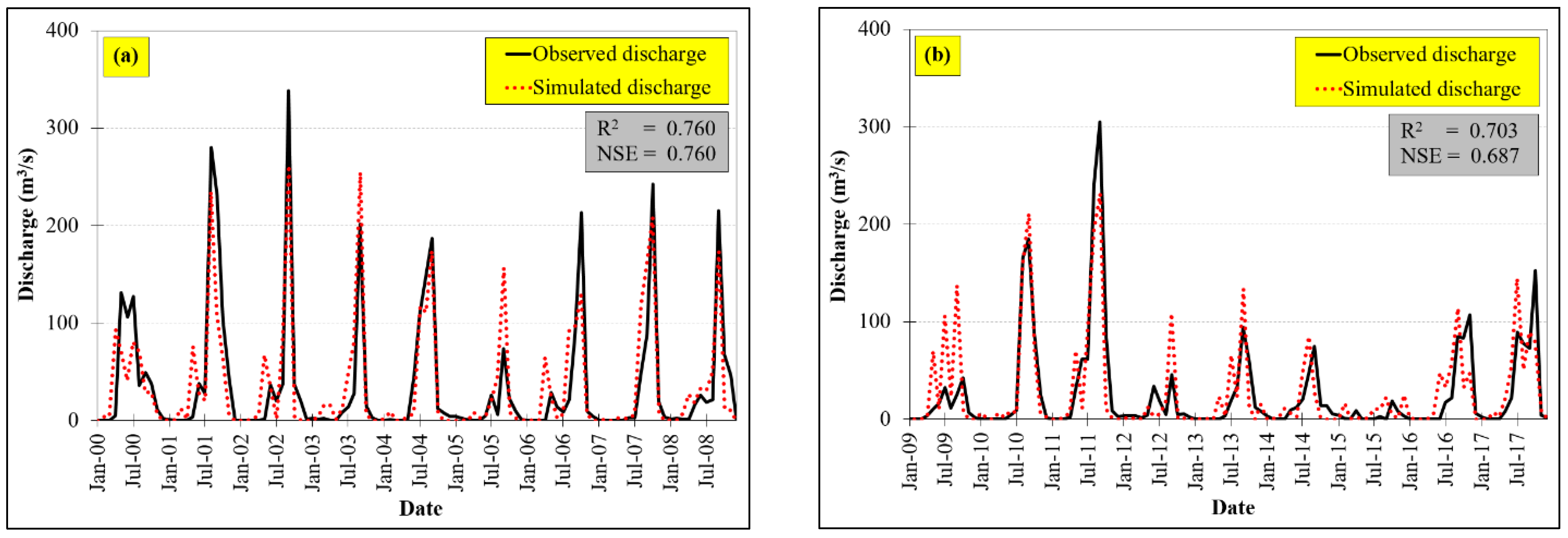

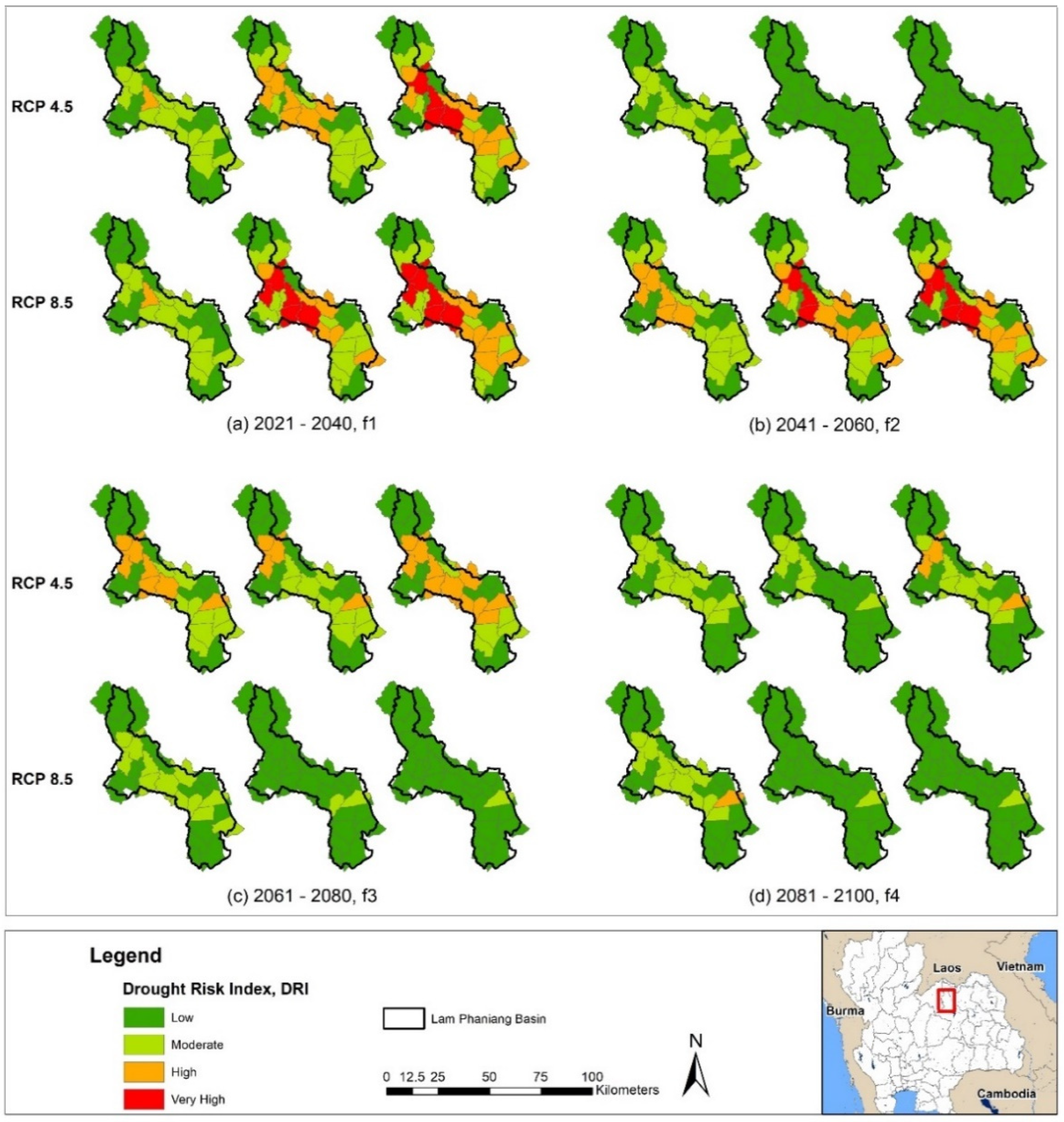
| SPEI Value | Classification | Weights Assigned |
|---|---|---|
| −1.00 to 1.00 | Near normal or mild (M) | 1 |
| −1.50 to −1.00 | Moderate (MO) | 2 |
| −2.00 to −1.50 | Severe (S) | 3 |
| −2.00 or less | Extreme (E) | 4 |
| DHI Value | Classification |
|---|---|
| 0.00 to 0.25 | Low |
| 0.25 to 0.50 | Moderate |
| 0.50 to 0.75 | High |
| 0.75 to 1.00 | Very High |
| Land Use Type | Period | ||||||||
|---|---|---|---|---|---|---|---|---|---|
| 2015 | 2021–2040 | 2041–2060 | 2061–2080 | 2081–2100 | |||||
| Area | Area | Change | Area | Change | Area | Change | Area | Change | |
| Aquaculture land | 1.3 | 1.3 | 0.0 | 1.3 | 0.0 | 1.3 | 0.0 | 1.3 | 0.0 |
| Field crop | 435.1 | 216.7 | −218.4 | 161.6 | −273.5 | 143.3 | −291.8 | 138.8 | −296.3 |
| Forest land | 407.1 | 366.6 | −40.5 | 337.5 | −69.6 | 312.5 | −94.6 | 291.6 | −115.5 |
| Horticulture | 0.9 | 0.9 | 0.0 | 0.9 | 0.0 | 0.9 | 0.0 | 0.9 | 0.0 |
| Miscellaneous land | 47.0 | 47.0 | 0.0 | 47.0 | 0.0 | 47.0 | 0.0 | 47.0 | 0.0 |
| Orchard | 21.4 | 11.1 | −10.3 | 9.7 | −11.7 | 9.5 | −11.9 | 9.7 | −11.7 |
| Paddy field | 642.5 | 665.3 | 22.8 | 673.1 | 30.6 | 677.3 | 34.8 | 679.8 | 37.3 |
| Pasture and farmhouse | 0.7 | 0.7 | 0.0 | 0.7 | 0.0 | 0.7 | 0.0 | 0.7 | 0.0 |
| Perennial crop | 183.7 | 407.6 | 223.9 | 473.3 | 289.6 | 503.5 | 319.8 | 519.2 | 335.5 |
| Urban and built-up land | 97.2 | 119.6 | 22.4 | 131.7 | 34.5 | 140.9 | 43.7 | 147.8 | 50.6 |
| Water body | 48.0 | 48.0 | 0.0 | 48.0 | 0.0 | 48.0 | 0.0 | 48.0 | 0.0 |
| Total | 1884.80 | 1884.80 | 1884.80 | 1884.80 | 1884.80 | ||||
| Water Balance Components | Period | RCP | Value (Million m3) | ||||||||||||
|---|---|---|---|---|---|---|---|---|---|---|---|---|---|---|---|
| Jan | Feb | Mar | Apr | May | Jun | Jul | Aug | Sep | Oct | Nov | Dec | Total | |||
| Runoff | 2000–2017 | - | 1.54 | 3.39 | 6.86 | 20.09 | 31.18 | 16.26 | 58.81 | 101.86 | 168.60 | 41.93 | 3.99 | 3.14 | 457.65 |
| 2021–2040 | 4.5 | 0.18 | 1.49 | 20.00 | 33.61 | 16.19 | 23.46 | 40.29 | 155.92 | 215.91 | 0.71 | 0.00 | 0.00 | 507.77 | |
| 8.5 | 0.06 | 2.64 | 12.36 | 32.64 | 11.07 | 20.95 | 45.89 | 181.26 | 236.11 | 0.76 | 0.00 | 0.00 | 543.75 | ||
| 2041–2060 | 4.5 | 0.08 | 1.90 | 19.32 | 45.06 | 18.30 | 24.28 | 32.84 | 193.29 | 194.21 | 0.27 | 0.00 | 0.00 | 529.55 | |
| 8.5 | 0.12 | 1.72 | 15.69 | 35.60 | 15.80 | 37.25 | 67.16 | 167.53 | 197.60 | 0.24 | 0.00 | 0.00 | 538.71 | ||
| 2061–2080 | 4.5 | 0.24 | 3.18 | 19.27 | 41.24 | 12.99 | 18.03 | 41.23 | 140.08 | 154.83 | 0.50 | 0.00 | 0.01 | 431.61 | |
| 8.5 | 0.23 | 3.06 | 21.46 | 43.10 | 14.07 | 19.73 | 40.28 | 194.31 | 193.71 | 0.42 | 0.00 | 0.01 | 530.38 | ||
| 2081–2100 | 4.5 | 0.11 | 3.17 | 23.04 | 42.58 | 13.31 | 15.61 | 39.37 | 136.66 | 143.63 | 0.13 | 0.00 | 0.00 | 417.63 | |
| 8.5 | 0.23 | 2.85 | 20.86 | 46.70 | 13.27 | 36.45 | 47.54 | 154.94 | 153.85 | 0.20 | 0.00 | 0.00 | 476.90 | ||
| Water demand | 2000–2017 | - | 47.14 | 52.04 | 56.97 | 50.10 | 69.62 | 88.38 | 68.54 | 51.53 | 30.35 | 73.79 | 64.47 | 41.52 | 694.43 |
| 2021–2040 | 4.5 | 33.04 | 32.88 | 29.96 | 21.98 | 63.73 | 69.08 | 63.10 | 25.09 | 6.44 | 77.79 | 65.32 | 27.90 | 516.29 | |
| 8.5 | 32.47 | 32.25 | 32.79 | 23.20 | 66.64 | 66.75 | 58.56 | 18.17 | 4.59 | 79.33 | 61.90 | 27.42 | 504.08 | ||
| 2041–2060 | 4.5 | 29.41 | 28.96 | 26.92 | 14.14 | 59.10 | 69.28 | 66.57 | 17.55 | 9.16 | 84.91 | 70.41 | 24.37 | 500.79 | |
| 8.5 | 28.98 | 28.65 | 28.23 | 17.99 | 60.41 | 60.61 | 57.64 | 22.27 | 8.36 | 89.53 | 74.16 | 24.06 | 500.90 | ||
| 2061–2080 | 4.5 | 29.04 | 27.26 | 26.23 | 14.52 | 64.43 | 68.92 | 54.01 | 24.93 | 14.73 | 86.76 | 75.10 | 23.83 | 509.77 | |
| 8.5 | 28.02 | 28.31 | 24.81 | 15.34 | 63.24 | 65.90 | 59.18 | 12.30 | 9.60 | 82.40 | 60.98 | 23.43 | 473.52 | ||
| 2081–2100 | 4.5 | 31.39 | 29.70 | 27.52 | 16.90 | 63.41 | 72.01 | 59.14 | 25.52 | 12.08 | 88.63 | 74.26 | 26.04 | 526.60 | |
| 8.5 | 31.64 | 29.84 | 28.54 | 16.88 | 63.37 | 58.59 | 56.90 | 21.48 | 14.18 | 91.97 | 80.49 | 26.75 | 520.61 | ||
| Water shortage | 2000–2017 | - | 42.84 | 42.33 | 36.70 | 20.19 | 16.08 | 17.61 | 11.42 | 1.22 | 0.23 | 21.31 | 42.97 | 36.03 | 288.93 |
| 2021–2040 | 4.5 | 30.38 | 20.39 | 1.77 | 0.17 | 2.36 | 3.77 | 8.82 | 0.00 | 0.00 | 16.36 | 54.82 | 27.09 | 165.92 | |
| 8.5 | 29.83 | 18.27 | 5.12 | 0.30 | 2.60 | 3.87 | 5.91 | 0.00 | 0.00 | 14.27 | 53.99 | 26.42 | 160.57 | ||
| 2041–2060 | 4.5 | 27.95 | 16.80 | 0.83 | 0.01 | 2.72 | 6.73 | 6.81 | 0.00 | 0.00 | 23.40 | 64.62 | 23.24 | 173.11 | |
| 8.5 | 26.65 | 16.80 | 3.03 | 0.06 | 2.19 | 3.26 | 2.42 | 0.00 | 0.00 | 27.21 | 68.06 | 23.45 | 173.14 | ||
| 2061–2080 | 4.5 | 26.64 | 12.85 | 0.64 | 0.03 | 2.02 | 6.10 | 4.13 | 0.00 | 0.00 | 25.44 | 64.66 | 22.53 | 165.04 | |
| 8.5 | 24.68 | 15.21 | 0.43 | 0.01 | 3.39 | 3.09 | 3.54 | 0.00 | 0.00 | 15.85 | 50.73 | 22.88 | 139.82 | ||
| 2081–2100 | 4.5 | 29.33 | 15.43 | 2.09 | 0.01 | 0.78 | 4.60 | 5.68 | 0.00 | 0.00 | 23.36 | 68.88 | 25.47 | 175.62 | |
| 8.5 | 28.60 | 16.20 | 0.81 | 0.00 | 1.25 | 5.38 | 5.61 | 0.00 | 0.00 | 30.79 | 75.73 | 26.09 | 190.46 | ||
| Period | Scenario | Average DRI Values at Different Time Scales | |||||
|---|---|---|---|---|---|---|---|
| 3-Month | 12-Month | 24-Month | |||||
| Value | Class | Value | Class | Value | Class | ||
| 2000–2017 | Baseline | 0.31 | Moderate | 0.23 | Low | 0.11 | Low |
| 2021–2040 | RCP 4.5 | 0.26 | Moderate | 0.37 | Moderate | 0.45 | Moderate |
| RCP 8.5 | 0.25 | Moderate | 0.45 | Moderate | 0.50 | High | |
| 2041–2060 | RCP 4.5 | 0.21 | Low | 0.09 | Low | 0.08 | Low |
| RCP 8.5 | 0.32 | Moderate | 0.40 | Moderate | 0.43 | Moderate | |
| 2061–2080 | RCP 4.5 | 0.30 | Moderate | 0.28 | Moderate | 0.38 | Moderate |
| RCP 8.5 | 0.21 | Low | 0.12 | Low | 0.08 | Low | |
| 2081–2100 | RCP 4.5 | 0.22 | Low | 0.16 | Low | 0.22 | Low |
| RCP 8.5 | 0.20 | Low | 0.06 | Low | 0.06 | Low | |
Publisher’s Note: MDPI stays neutral with regard to jurisdictional claims in published maps and institutional affiliations. |
© 2021 by the authors. Licensee MDPI, Basel, Switzerland. This article is an open access article distributed under the terms and conditions of the Creative Commons Attribution (CC BY) license (https://creativecommons.org/licenses/by/4.0/).
Share and Cite
Kuntiyawichai, K.; Wongsasri, S. Assessment of Drought Severity and Vulnerability in the Lam Phaniang River Basin, Thailand. Water 2021, 13, 2743. https://doi.org/10.3390/w13192743
Kuntiyawichai K, Wongsasri S. Assessment of Drought Severity and Vulnerability in the Lam Phaniang River Basin, Thailand. Water. 2021; 13(19):2743. https://doi.org/10.3390/w13192743
Chicago/Turabian StyleKuntiyawichai, Kittiwet, and Sarayut Wongsasri. 2021. "Assessment of Drought Severity and Vulnerability in the Lam Phaniang River Basin, Thailand" Water 13, no. 19: 2743. https://doi.org/10.3390/w13192743
APA StyleKuntiyawichai, K., & Wongsasri, S. (2021). Assessment of Drought Severity and Vulnerability in the Lam Phaniang River Basin, Thailand. Water, 13(19), 2743. https://doi.org/10.3390/w13192743







